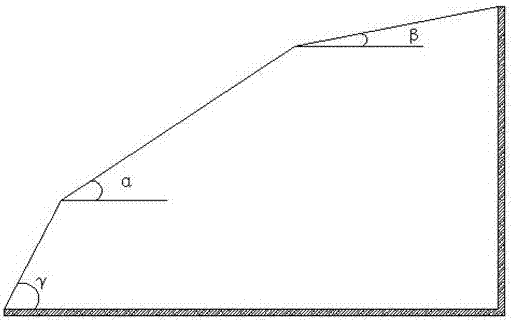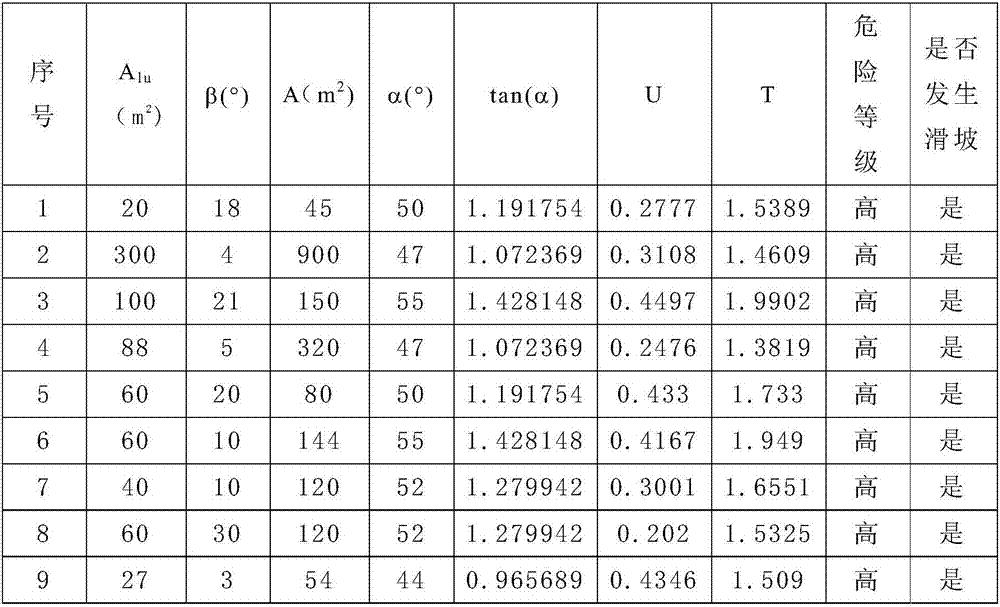Early recognition method of loess shallow landslide and application thereof
An early identification and loess technology, applied in the field of early identification of shallow loess landslides, can solve the problems of complex early warning work, low early warning efficiency, and poor applicability of disaster prevention, and achieve the effect of improving the applicability of disaster prevention and shortening the response time of early warning
- Summary
- Abstract
- Description
- Claims
- Application Information
AI Technical Summary
Problems solved by technology
Method used
Image
Examples
Embodiment 1
[0029] An early identification method for shallow loess landslides, comprising the following steps:
[0030] a. Determine the basic topographic data of the landslide body through on-site investigation and mapping, the slope of the landslide body α, the area of the landslide body A, the slope of the upper rear edge of the landslide body β, and the area of the upper rear edge of the landslide body A Lu and the slope of the lower free surface γ;
[0031] b. By U=tan(α-β)*(A Lu / A) Calculate the slowing factor U, where β<α;
[0032] c. When γ>α, there is an empty surface, and the terrain comprehensive discrimination factor T of the landslide body is calculated by T=tan(α)+1.25U;
[0033] d. According to the topographic comprehensive discriminant factor T of the landslide body, the hazard level of the shallow loess landslide is divided into three levels: low, medium and high.
[0034] Determine the basic terrain data of the landslide body through on-site investigation and ma...
Embodiment 2
[0036] An early identification method for shallow loess landslides, comprising the following steps:
[0037] a. Determine the basic topographic data of the landslide body through on-site investigation and mapping, the slope of the landslide body α, the area of the landslide body A, the slope of the upper rear edge of the landslide body β, and the area of the upper rear edge of the landslide body A Lu and the slope of the lower free surface γ;
[0038] b. By U=tan(α-β)*(A Lu / A) Calculate the slowing factor U, where β<α;
[0039] c. When γ>α, there is an empty surface, and the terrain comprehensive discrimination factor T of the landslide body is calculated by T=tan(α)+1.25U;
[0040] d. According to the topographic comprehensive discriminant factor T of the landslide body, the hazard level of the shallow loess landslide is divided into three levels: low, medium and high.
[0041] In the step d, three grades means that when βα, and T>1.35, the risk of landslide is high; ...
Embodiment 3
[0044] An early identification method for shallow loess landslides, comprising the following steps:
[0045] a. Determine the basic topographic data of the landslide body through on-site investigation and mapping, the slope of the landslide body α, the area of the landslide body A, the slope of the upper rear edge of the landslide body β, and the area of the upper rear edge of the landslide body A Lu and the slope of the lower free surface γ;
[0046] b. By U=tan(α-β)*(A Lu / A) Calculate the slowing factor U, where β<α;
[0047] c. When γ>α, there is an empty surface, and the terrain comprehensive discrimination factor T of the landslide body is calculated by T=tan(α)+1.25U;
[0048] d. According to the topographic comprehensive discriminant factor T of the landslide body, the hazard level of the shallow loess landslide is divided into three levels: low, medium and high.
[0049] In the step d, three grades means that when βα, and T>1.35, the risk of landslide is high; ...
PUM
 Login to View More
Login to View More Abstract
Description
Claims
Application Information
 Login to View More
Login to View More - R&D
- Intellectual Property
- Life Sciences
- Materials
- Tech Scout
- Unparalleled Data Quality
- Higher Quality Content
- 60% Fewer Hallucinations
Browse by: Latest US Patents, China's latest patents, Technical Efficacy Thesaurus, Application Domain, Technology Topic, Popular Technical Reports.
© 2025 PatSnap. All rights reserved.Legal|Privacy policy|Modern Slavery Act Transparency Statement|Sitemap|About US| Contact US: help@patsnap.com



